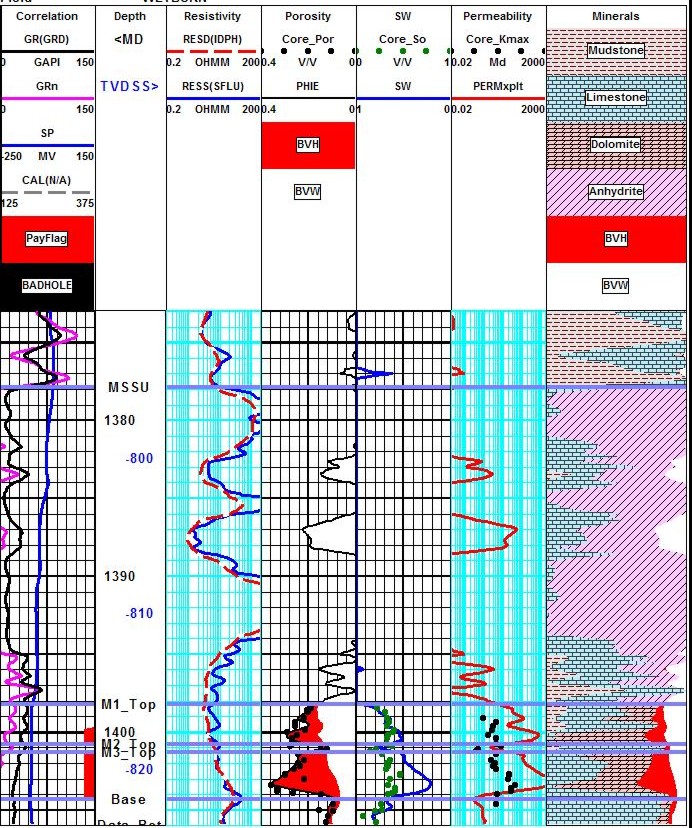|
 Moveable Hydrocarbon Saturation
Moveable Hydrocarbon Saturation
Since water saturation is the natural result of the previous calculations,
it is often reported by the log analyst as one of "the answers".
However, it is the amount of oil or gas, not water, that is wanted.
This information flows from the following equations.
Total
hydrocarbon saturation:
1: Shy = 1.00 - Sw
Residual
hydrocarbon saturation:
2: Shr = 1.00 - Sxo
Moveable
hydrocarbon saturation:
3: Smo = Shy - Shr
OR 3A: Smo = Sxo - Sw
Recovery
Factor:
4: RF = Shr / Shy
Where:
Sxo = water saturation in invaded zone (fractional)
Sw = water saturation in un-invaded zone (fractional)
Shy = hydrocarbon saturation in un-invaded zone (fractional)
Shr = residual hydrocarbon saturation in invaded zone (fractional)
Smo = moveable hydrocarbon saturation (fractional)
 COMMENTS:
COMMENTS:
These saturations are needed in order to find hydrocarbon volume
which could be produced from the well.
CAUTION: There
are many situations where Smo cannot be calculated, and many silly
results have been presented to clients over the years. If invasion
is very shallow, Smo may be zero when in fact the zone is an excellent
producer. Likewise, deep invasion gives useless results. If your
computer program insists on calculating Smo, you will have to
fiddle with RMF to get rational results, or set RMF > 10 to
make Sxo = 1.0 always.
 Fluid Volume Calculations Fluid Volume Calculations
For reserves calculations, it is sometimes convenient to convert
saturations to volume of fluid per unit volume of rock. These
volumes are often called bulk volume and the "per unit rock
volume" is unstated. These volumes are also needed when using
computers for plotting log analysis results versus depth.
Water
volume:
5: Vwatr = PHIe * Sw
Total
hydrocarbon volume:
6: Vhydt = PHIe * Shy
Moveable
hydrocarbon volume:
7: Vhydm = PHIe * Smo
Residual
hydrocarbon volume:
8: Vhydr = PHIe * Shr
Rock
matrix volume:
9: Vrock = 1.00 - PHIe - Vsh
Where:
PHIe = porosity from any method (fractional)
Shr = residual hydrocarbon saturation in invaded zone (fractional)
Shy = hydrocarbon saturation in un-invaded zone (fractional)
Smo = moveable hydrocarbon saturation (fractional)
Sw = water saturation in un-invaded zone (fractional)
Vrock = volume of matrix (fractional)
Vsh = volume of shale (shale content) (fractional)
Vhydt = bulk volume hydrocarbon (fractional)
Vhydm = bulk volume moveable (fractional)
Vhydr = bulk volume residual (fractional)
Vwatr = bulk volume water (fractional)
 COMMENTS:
COMMENTS:
This data is used to calculate hydrocarbons in place and recoverable
reserves.
When
making depth plots of log analysis results, the usual approach
is to plot the following curves on a scale of zero to one:
Value to Plot Result
Vwatr water volume
Vwatr + Vhydm moved hydrocarbon
Vwatr + Vhydm + Vhydr residual hydrocarbon
Vwatr + Vhydm + Vhydr + Vrock matrix rock plus porosity
The
remaining distance to the border of the track will be Vsh, the
shale volume. If bound water volume is desired on the plot, it
can be presented as part of the shale volume by plotting;
Vwatr + Vhydm + Vhydr + Vrock + (Vsh * BVWSH)
If
the rock volume is broken into two or more constituents then these additional curves should be plotted
and shaded appropriately.
 Moveable Hydrocarbon EXAMPLE
Moveable Hydrocarbon EXAMPLE
This example shows a comparison of residual oil from core in a
depleted zone (M1 interval) and in a bypassed zone (M3 interval).
The Sor from core equals (1 - SW) from log analysis, so there is no
moveable oil in the M1. The close match suggests that most of the
saturation parameters (A, M,
N, RW@FT) and porosity are reasonably well calibrated. Since the
world abounds with depleted zones (most are well known to the well
operators) this test should always be made to confirm SW parameters
where ever core data is available.

Computed results for carbonate example. Note higher water saturation
on M1 compared to M3. M3 is bypassed pay. M1 is depleted oil. Dots
are core data. Note that residual oil on core in M1 matches
calculated
Sor = (1 - SW). In M3, Sor on core is less than (1 - SW) from log
analysis, so there is moveable oil in
M3 interval. Calibration to core permeability needs more work to get a
decent match.
|

